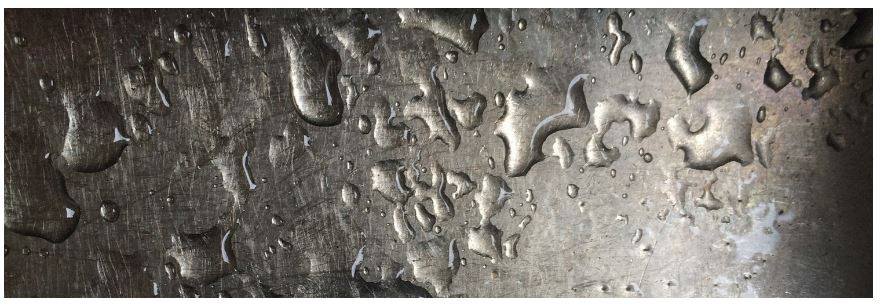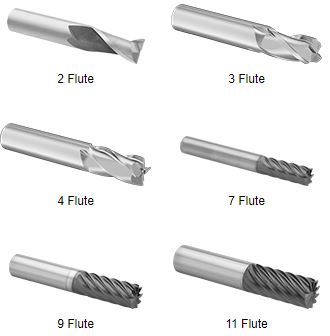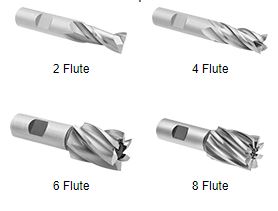
INTRODUCTION
What is stainless steel in basic terms? It is the alloy steel that has chromium more than 12% or nickel more than 8%. In corrosive media, this element shows corrosive resistance in atmosphere and at high temperatures >450°C, it shows high strength. When the percentage of chromium in steel is between 16%-18%, it becomes acid-resistant steel or acid-resistant stainless steel.
The unique physical properties of stainless steel make it difficult to select the right end mill which delivers the requirements and simultaneously does not damage the material as well as machine.
Here, we will discuss some important information about stainless steel and factors that guides to selection of right end mills. This section covers following:
- Grades of stainless steel
- Features of stainless steel while processing
- Selection of end mill for stainless steel
- Machine cutting parameters
- Application of CNC-processed stainless steel
GRADES OF STAINLESS STEEL
The stainless steel is scale, acid, impact and toughness resistant in many temperature ranges. It becomes an ideal choice in many applications because it provides various grades and surface finishes. The chromium present in the steel forms an invisible, rough film made up of chromium oxide which prevents from corrosion.
There are 5 different categories for stainless steel. These 5 categories are named due to these alloy elements that affect microstructure.
Following are brief details of each category:
MARTENSITIC GRADE
- The martensitic grade steels are capable to hardened in heat treatments and resistant to corrosion. They are magnetic and made from pure chromium steel with absence of nickel. They are used to provide strength, wear resistance and hardness.
Pump shafts, valves, rivets, bolts, jet engines and mining machinery etc. are made from Martensitic grade steel. The common grades included in this alloy are 410, 414, 420, 431, 414, and 440.
Out of many 2 common grades within Martensitic steel are discussed below:
Type 410
It contains lowest alloy content. It is a low cost steel grade and contains minimum of 1.5% chromium which is why it is specifically resistant to acids and chemical corrosion. It is used to manufacture products that delivers combination of corrosion resistivity and strength like fasteners
Type 414
This grade is not anti-corrosive so 2% nickel is added to improve resistivity, products made from this grade are pressure plates, surgical instruments, valve components, bolts etc.
AUSTENITIC GRADE

It is one of the most commonly used non-magnetic stainless steel. Its most common alloy is iron-chromium-nickel steel known as 300 series. It is highly formidable and maintains strength even at high temperatures. It is used to make shafts, valves, aircraft accessories etc.
It further breaks into low and high carbon grades as follows:
Low Carbon Grade (L grade)
These grades are recognized by their names such as 304L. The letter L means low carbon which should be maintained at 0.03% or lower to prevent carbide precipitation which can be generated while welding.
High Carbon Grade (H grade)
It has minimum 0.04% carbon content. This type of stainless steel is used when high strength is required even at extreme temperature environment.
FERRITIC GRADE
Similar to martensitic steel, they are also pure chromium steel having no nickel content and offers resistance to cracking and stress. Though these steels are magnetic, they do not harden by heat treatment but are cold worked. Most common application of them are some automotive applications and decorative strips etc.
Following are some of its types:
Type 405
It contains aluminum and chromium. When cooled from extreme temperatures, it resists hardening which is why it is ideal for welding applications. It is easily shaped and processed. Products like steam turbine, quenching parts and heat exchangers etc. are made from it.
Type 442
Because it contains high quantity of chromium, it is highly corrosive. It has anti-scalping properties and is difficult to process. Products like nitric acid storage tanks, combustion parts etc. are made from it.
DUPLEX STAINLESS STEEL

Its microstructure is a mixture of austenite and ferrite. It contains high chromium and low molybdenum and low nickel content.
They are almost twice the strength of austenitic stainless steel and is resistant to corrosion by chloride.
It is further classified into 4 categories:
The 1st category is a low alloy that does not contain molybdenum and consists of PREN between 24-25.
The 2nd category is medium alloy contain PREN value between 32-33, 22 chromium, 0.15 nitride, 5 nickel and 3 molybdenum.
The 3rd category is high alloy type containing 25% chromium, nitrogen and molybdenum.
The last 4th category is a super duplex stainless steel containing highest nitride and molybdenum, some tungsten and copper. It is suitable for harsh conditions and is good corrosion resistance.
STAINLESS STEEL FEATURES WHILE PROCESSING
After multiple analysis of stainless steel over CNC machining, SANS has provided following features stainless steel shows while processing:
LARGE CUTTING FORCE
The stainless steel shows large plastic deformation while processing which requires more cutting force. It has high thermal strength and work hardening which enhances cutting resistance. It is also difficult to break and curl the chips during milling.
SEVERE WORK HARDENING
Following are the factors that contribute to work hardening:
Stainless steel has:
- Large plasticity
- Distorted character during plastic deformation
- Large strengthening coefficient
- Unstable austenite under cutting stress
- Transformable parts into martensite under cutting heat action
- Ability to decompose and distribute impurities easily
HIGH CUTTING TEMPERATURES
During heavy working and high friction, extreme cutting heat is generated because cutting heat is heavily concentrated between tool-chip contact and cutting area. The heat dissipation in this process is very poor.
TOOL WEARS EASILY
During cutting of the stainless steel, diffusion and bonding between the tool and chip occurs that results in diffusion and bonding wears. This ultimately produces tiny cutting edges because stainless steel has high content of carbide particles.
CHIPS DO NOT BOND AND BREAK EASILY
Stainless steel consists of high toughness and plasticity which is why it forms continuous chips while machining. This affects the smooth machine operation as well as crushes processed surface. Under extreme pressure and heat, the stainless steel suffers from adhesion with other metals which not only wears the tool but also damages the processed surface.
LINEAR EXPANSION COEFFICIENT IS LARGE
The coefficient of linear expansion of stainless steel is 1.5 times higher than carbon steel. The material suffers from thermal deformation during cutting temperature and so it becomes hard to control dimensional accuracy.
Though the stainless steel has some pros and cons in above-mentioned processing features, selecting the right cutting tool, cutting fluid, processing method and cutting amount greatly impacts the quality of the material.
WHICH END MILL TO USE FOR CUTTING STAINLESS STEEL?
Once you know the material’s properties and how it functions under machining process, it becomes easy to select the cutting tool.
COATED AND UNCOATED END MILLS
There are two types of coating used in end mills for stainless steel milling process, coated and uncoated.
The coated end mills are primarily used for milling soft materials which gets adhesive under increasing temperatures and stick to the material thereby damaging the tool and material both. The uncoated end mills are used for milling in general purposes and short period production runs.
TYPES OF COATING ON END MILLS
The end mills for stainless steel are available in 4 types of coating which is briefly described below:
Titanium-Nitride (TiN) – It creates less friction and last longer at constant speed.
Titanium-Carbonitride (TiCN) – it resists wear and chipping and avoids material prevention from accumulation during machining.
Titanium-Aluminum-Nitride (TiAIN) and Aluminum-Titanium-Nitride (AlTiN) – Both dissipates heat compared to other end mills at fast speeds. This coating contains layer of aluminum oxide that transfers heat to chips and keeps the tool cool.
SELECTION OF END MILLS
End mills for stainless steel or even any other material are used for slotting, plunging, roughing or smooth finishing. The most important factor in an end mill depends on number of flutes. The lesser the flutes the harder material it mills and vice versa. For stainless steel, 4-flute end mills are used for general milling purpose but for finishing, 6-flute end mills are used.
But end mills also come more than 6 flutes. Some of the end mills with lowest and highest number of flutes are discussed below:
CARBIDE SQUARE END MILL
-

Purpose – These end mills are used for longer tool life and general purposes machining purposes. They are hard end mills and provides more strength and wear resistance compared to high-speed or cobalt end mills. Since they are very brittle, they need to be worked on highly-rigid CNC machine to avoid tool breakage. They are square-end end mills which can be used for making pockets, edges and slots.
Flutes and coatings– They are available in 2, 3, 4, 7, 9 and 11 flutes and are also available in uncoated as well as all 4 types of coating material discussed above.
Usage – Apart from stainless steel, they are also used for brass, aluminum, nickel, titanium, bronze etc.
Type – Centre cutting
Other square end mills – Fast cutting, fast cutting with chamfer corner, over-size tolerance, fast cutting roughing, carbide square bur end mill, roughing carbide square end mill. etc
CARBIDE BALL END MILL
-

Purpose – These end mills consists of same properties as carbide square end mills with the exception that they are used to mill rounded slots, contours, slopes etc. because they have a ball end.
Flutes and coatings – They are available in 2, 3, 4 flutes and are also available in uncoated as well as all 3 types of coating material; TiN, TiCN, TiAN.
Usage – Apart from stainless steel, they are also used for brass, aluminum, nickel, titanium, bronze, plastic etc.
Type – Centre cutting
Other ball end mills – fast cutting, ball end mill for fiberglass/graphite/carbon fiber, ball end mill with two milling ends, high speed ball end mill etc.
HIGH SPEED STEEL SQUARE END MILL
Purpose – They have square end therefore they are used for making square edges, slots and pockets.
Flutes and coatings – They are available in 2, 3, 4, 6, & 8 flutes and are also available in uncoated as well as all one coating TiN (Titanium Nitride).
Usage – Apart from stainless steel, they are also used for brass, aluminum, tool steel, hardened steel, nickel etc.
Type – Centre cutting
Other high speed steel square end mills – Roughing, undersized tolerance, high speed steel end mill with two milling ends, etc.
COBALT STEEL SQUARE END MILL
-

-
Purpose – These type of end mills offer good wear and heat resistance compared with high spee steel end mills. On hard materials, they are capable to run at high speeds and deliver good performance. They also have square end therefore they are used for making square edges, slots and pockets.
Flutes and coatings – They are available in 2, 4, 6, & 8 flutes and are also available in uncoated as well as all one coating TiCN (Titanium-Carbo-Nitride).
Usage – Apart from stainless steel, they are also used for brass, aluminum, nickel, titanium, bronze etc.
Type – Centre cutting
Other cobalt steel square end mills – Roughing, end mill for aluminum, bronze, and brass, cobalt steel square end mill with two milling ends.
HIGH SPEED STEEL TAPERED END MILLS

- Purpose – They are commonly known as taper degree end mills and used to machine angled slots and plunge in molds and dies.
Flutes and coatings – They are available in 3 and 4 flutes and are only available in uncoated material.
Usage – Apart from stainless steel, they are also used for brass, aluminum, iron, bronze etc.
Type – Centre cutting
Other high speed steel tapered square end mills – carbide tapered square end mills and carbide tapered ball end mills.
CUTTING PARAMETERS FOR STAINLESS STEEL
The cutting process for stainless steel is divided into finishing and roughing. For finishing, a cemented carbide that contains high TiC. But for roughing requirements, use a cemented carbide with low TiC content.
To prevent edge chipping during stainless steel processing, it is recommended to increase strength of blade and reduce rake angle. If the steel in action is made of hard alloy, select the helix angle between 5-10 degrees.
If you are working with high-speed steel end mills, helix angle between 35-45 should be selected. Select end mill for stainless steel with larger helix angle when working with thick-walled material. But when working with stainless steel with thin walls like pipes, it is preferred to use a corner end mill.
Coolants also play vital role in removing the built-up heat in the workpiece and cutting zone and also gives lubrication to reduce the friction between chips removal and end mill. When using cutting materials that are prone to corrosion, the coolants protects the material and tool to corrode.
Below are some of the other cutting parameters for stainless steel milling:
- Cutting speed 10~140 m/min and feed rate 0.013~0.15 mm/Z
- Avoid high-speed steel end mill for high-hardness stainless steel
- Lower milling amount for higher hardness for steel
- Lower milling amount when having large side tool
- For coated carbide end mills, increase milling speed to 50%
- Allow for full cooling off when cutting.
- Avoid using water-soluble cutting fluid while using cemented carbide tools. This will prevent material chipping caused by thermal stress on cutting edges.
APPLICATION OF STAINLESS STEEL MACHINED PARTS
The stainless steel is used widely in fields of aviation, aerospace, electric power, food and petroleum industries. Below are some of its uses in some industries:
Automotive industry – The material is mainly used in the manufacturing of exhaust system, car decoration parts, fuel tank etc.
Household and electronic industry – Its main usage is coffee machine heating tubes, current water heaters etc.
Medical industry – It is used in making of items like, wheelchairs, infusion stands, medical tweezers, needles etc. are some of the everyday usage items.
CONCLUSION
Stainless steel shows specific properties when milled on CNC machines. Though it is common knowledge in manufacturing industry about functions of different types of end mills, keeping the special processing requirements of stainless steel in mind helps to set the specialized cutting parameters and careful selection of end mills for stainless steel. This ultimately results in maximum output from the CNC milling machine.








